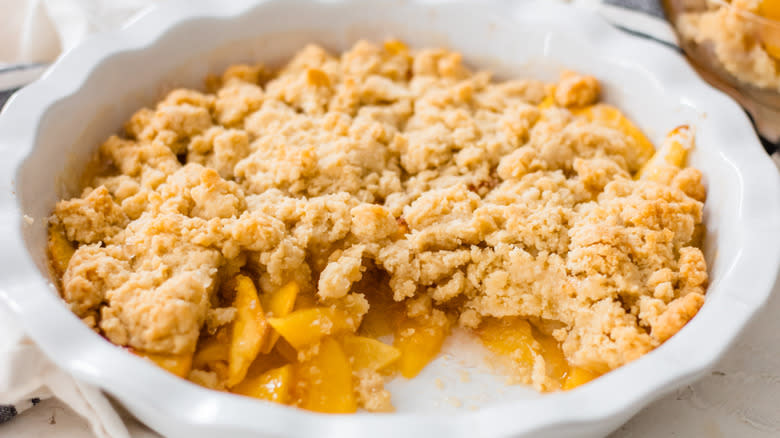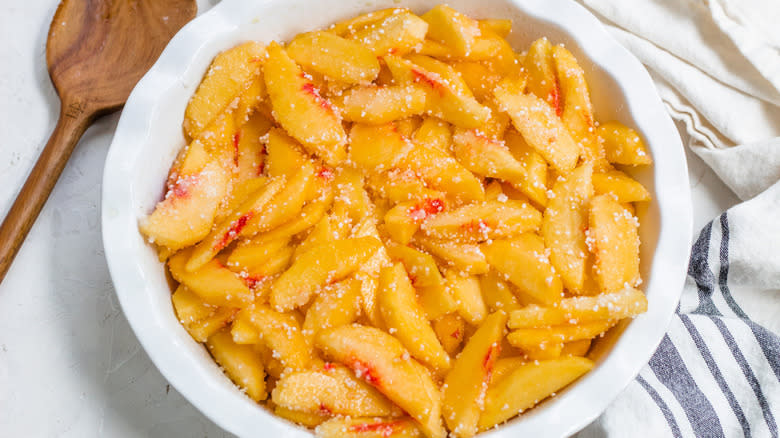The Absolute Best Way To Prevent Runny Peach Cobbler

One of the highlights of summer is the season's bounty of sweet, juicy fruits — and peaches are among the cream of the crop. With some of the sweetest, most fragrant flavors around, peaches are prime cobbler fodder. Unfortunately their juiciness can sabotage the cobbler consistency you crave. Luckily, there's a simple way to prevent a runny peach cobbler while still taking full advantage of peaches' natural abundance of juice.
The best way to make a cohesive peach cobbler is to toss cornstarch into the filling. Cornstarch is a well-known and widely used thickening and binding agent. Just as a cornstarch slurry turns a soupy stir-fry sauce into an almost gelatinized consistency, a couple of teaspoons of cornstarch will transform peach juice into the perfect jammy coagulant. Not only will cornstarch thicken cobbler juice, but it'll also give the filling more cohesion and help anchor the cake or biscuit batter topping to eat for a well-rounded spoonful.
There's no trick to adding cornstarch; peach cobbler filling is usually a one-bowl dump recipe, and cornstarch is just another one of the ingredients you'll dump in. A standard 9-by-11-inch pan of cobbler calls for between 2 teaspoons and 1 tablespoon of cornstarch. If you don't have cornstarch, tapioca is another tasteless binder and thickener that works just as well. In fact, Tasting Table's recipe for a classic peach cobbler uses tapioca instead of cornstarch. You'll need much more of it than you would cornstarch, though; our recipe calls for 3 tablespoons of tapioca.
Read more: 30 Types Of Cake, Explained
More Peach Cobbler Tips

A runny filling isn't the only mistake you could make with your peach cobbler. Not only is cornstarch a quintessential factor for filling consistency, but the size and form of your peaches is just as key to a successful texture. Chunks are better than slices, and you should ensure that every chunk is uniform in size with a minimum thickness of half an inch. If the chunks are too small, they'll break down into a mealy mess as they cook. Another way to avoid a soupy filling is to use a shallow baking dish. This will equalize the proportion of fruit to topping so you'll get a well-balanced contrast of gooey filling to crispy cake.
Peaches are some of the sweetest summer fruits, so you might want to ease back on the added sugar if your peaches are especially ripe. You could even add a squeeze of lemon juice to balance the sweetness while enhancing the fruitiness of the peach. Better yet, pair peaches with a tart summer fruit like blackberries or raspberries. You could also use a more savory topping like a buttery buttermilk biscuit.
Of course, the only thing as disappointing as a runny filling is a soggy topping. Some tips to avoid a doughy or mushy topping is to ensure there's space between the dollops of biscuit dough to give excess liquid from the filling the chance to evaporate. Overcrowded topping will trap liquid, thwarting any chance at fluffy crumbs and crispy crusts.
Read the original article on Tasting Table.


